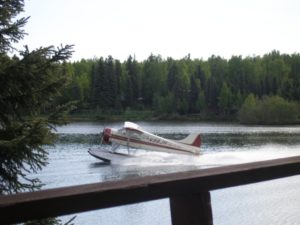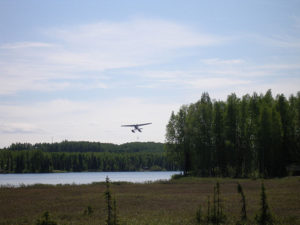INM Version 7.0c and Floatplanes in Alaska
01.05.2012 | HMMH |
If you have not heard, the Federal Aviation Administration (FAA) just released Version 7.0c of its Integrated Noise Model (INM). This update is almost entirely about database changes, and a lot of them, including:
- Updated noise information for nineteen aircraft
- Nine Airbus jets
- Six props
- Four helicopters
- Sixty-eight changes to aircraft substitutions
- Twenty-two new
- Thirty-eight modified
- Eight deleted
- Eleven new aircraft
- Five Cessna jets
- Four Bell helicopters
- Two single-engine floatplanes
- Modified arrival profiles for twenty-one aircraft
- Sixteen Airbus and Boeing jets (updated reverse thrust segment)
- Five props (added final landing segment)
There are a few other changes, but you can find those in the release notes. I’m an instructor for HMMH’s INM Training Course so I take an interest in any new releases, but there was something special about this one. In the list above, I’m fairly confident that the thing that jumps out at everyone is the floatplanes. Or maybe that’s just me. Let’s do a little backstory here.
In June of 2007 I was at Willow Lake, Alaska doing noise measurements for a study of floatplane noise. Willow Lake is just up the road from the now (in)famous city of Wasilla. Each year, the frozen lake is used as the restart point for the Iditarod dog sled race. It’s a scenic little lake, surrounded by forest with houses, cabins, and a community center along the shore. It is also used by floatplanes.


Floatplane Departure, Willow Lake, AK
The weather for the measurement program was great and the residents around the lake were friendly and helpful. Folks in Alaska love their airplanes. It is by far the most aviation-literate population that I have ever met. Everyone seemed to be a pilot, have been a pilot, or at the bare minimum, have a pilot in the family. Given the love of airplanes and the low operations levels (approximately twenty operations per day in-season), why was the study necessary?
In short, the floatplanes, particularly the de Havilland DCH-2, are loud and due to the size of the lake and proximity of the houses to the shore, the planes are quite close to residential locations when they are applying full thrust to get off the water. Here’s a picture of a Beaver taking off from the deck of residence along the shore.

De Havilland DHC-2 Beaver Take-off, Willow Lake, AK
At full throttle, that radial piston engine and whirling propeller produced maximum levels averaging 112 dBA at this location for northbound departures. A single northbound DHC-2 departure per day would give a Day Night Average Sound Level (DNL) of 70 dB. Actual average levels were quite a bit lower due to a much higher percentage of southbound departures and the fact that the lake is frozen most of the year. Still, after experiencing this firsthand, I was impressed by the tolerance of the locals.
After the measurement program, it was time to model the average annual conditions for our report. At that time INM 7.0 was the most current version and the DHC-2 was modeled using the GASEPV, a generic single engine piston aircraft with a variable-pitch propeller. Unfortunately, that aircraft produced levels that were nine to twenty-three decibels too low compared to the measurements, depending on the location along the flight path. To put twenty-three decibels in perspective, using that aircraft would be the same as using an accurate aircraft, but modeling one two-hundredths of the correct number of operations.
After no small amount of work and worry, I ended up creating a user-defined aircraft by modifying the GASEPV to have a much longer take-off distance and increased source noise levels. This produced a reasonable representation of the Beavers operating on the Lake.
Let’s jump back to 2012 and the release of INM 7.0c. It has a new aircraft, a DHC-2 floatplane. Let’s see how it compares on the most common departure path at Willow Lake. The table below includes measured values and the INM 7.0c computed Sound Exposure Level (SEL) and take-off roll distances for the GASEPV (INM 7.0 representation of the DHC-2), my user-defined aircraft, and the new DHC-2FLT.
| Item |
Description |
Measured |
GASEPV |
User-Defined |
DHC-2FLT |
| Site 1 SEL (dBA) |
near start of takeoff |
99
|
94
|
103
|
93
|
| Site 2 SEL (dBA) |
take-off “roll” |
109
|
93
|
103
|
91
|
| Site 3 SEL (dBA) |
just after take-off |
103
|
93
|
105
|
105
|
| Site 4 SEL (dBA) |
after take-off |
103
|
94
|
102
|
101
|
| Take-off Roll (ft) |
|
1,340
|
630
|
1,340
|
1,594
|
Well, nothing hits the measurements exactly at all points, but the user-defined aircraft and the new DHC-2FLT are clearly better than the old substitution. Of course the user-defined aircraft was developed from precisely this particular set of measurement data so the agreement is not surprising. The agreement with the new standard INM data is nice to see though. The development of this data for the new DHC-2FLT will be detailed in a US DOT Volpe National Transportation Systems Center report which is pending publication (see the INM 7.0c release notes).
The discrepancies for the take-off roll portion are not entirely unexpected. First, the measurements may slightly overstate the SEL by including some taxi noise. Second, water is a hard reflective surface and the INM will underestimate the levels when the primary reflected path is off the water due to the inclusion of a soft-ground effect. You can remove this effect for props in the INM, but it would do that at all sites which would throw off the results at Sites 3 and 4 where the soft-ground assumption is more appropriate. Third, the measurements were of a limited number of aircraft which performed the majority of the operations on this particular lake. The general fleet may be slightly different.
So there you have it, INM 7.0c is out and it has two new floatplanes. This may not matter to most folks, but I can remember a few months back 2007 when this would have made my life a lot easier.








